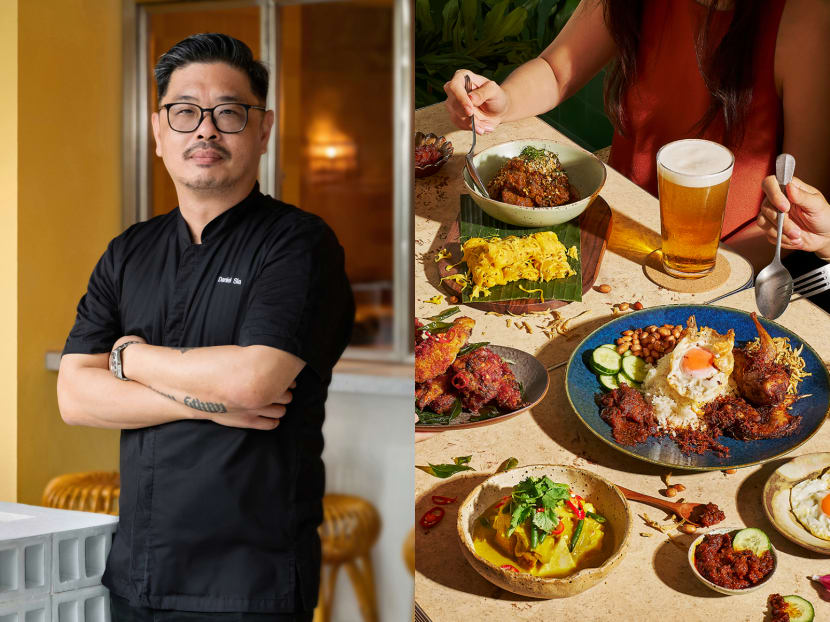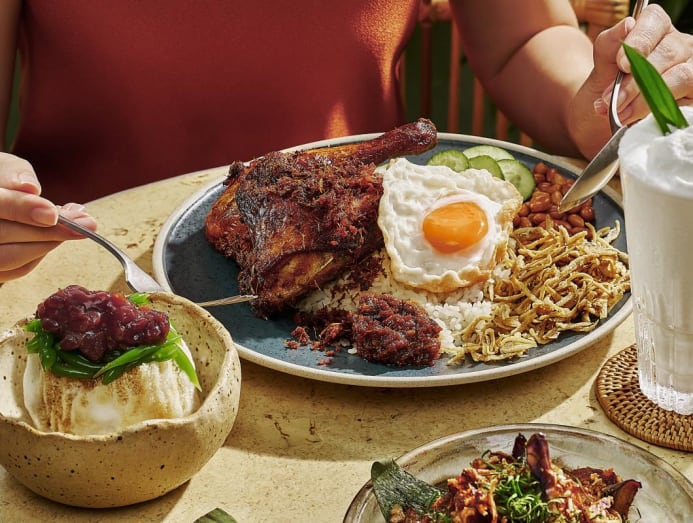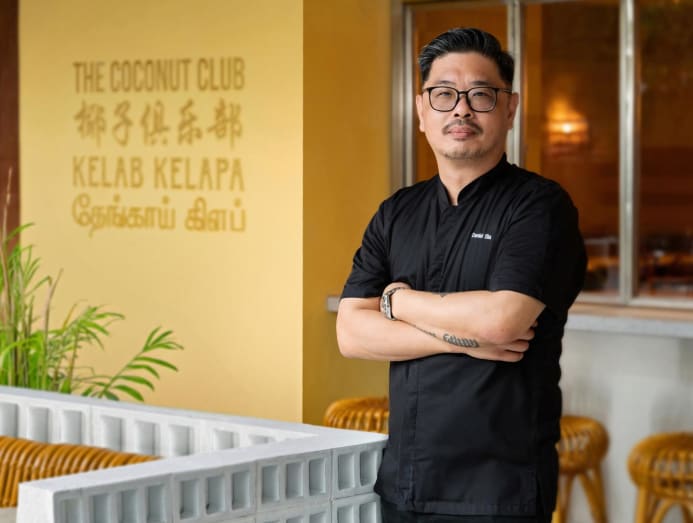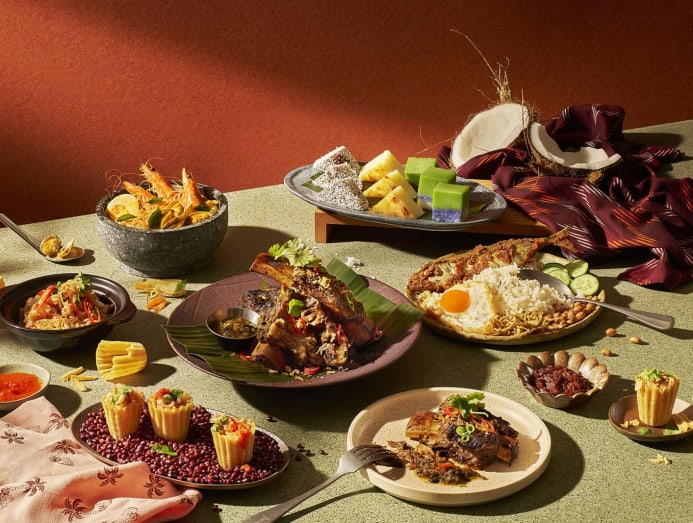Beyond nasi lemak: The Coconut Club’s Daniel Sia is taking the Singapore brand overseas
The Coconut Club’s three outlets at Beach Road, Siglap and the latest one at River Valley are expressions of what the brand can be overseas – from casual communal dining to breezy day-to-night hangouts.

The Coconut Club's managing partner, Daniel Sia (left) and (right) local favourites served at the restaurant. (Photos: The Coconut Club)

This audio is generated by an AI tool.
The latest addition to The Coconut Club’s (TCC) nasi lemak fanfare opened on Tuesday (Jun 11) in River Valley, the third one after its Beach Road flagship in 2022 and Siglap outlet along Frankel Avenue in 2023.
The retro-futuristic 69-seat eatery, which has a five-seat bar counter and covered outdoor terrace, is nestled in the New Bahru lifestyle destination, housed at the former Nan Chiau High School.
This latest outlet has been touted as a hybrid between the flagship’s full restaurant offerings and Siglap’s canteen-style setup. It is also an experiment in day-to-night dining in a hipster enclave.
All three encapsulate the different operational models that TCC’s managing partner Daniel Sia is considering for the concept’s overseas expansion, with nasi lemak at the centre and a supporting cast of Singaporean favourites such as laksa and soto ayam.

While Sia is keeping mum about the details, saying that they are “still exploring and looking at the feasibility of different markets”, he lets on that he is targeting three places as a start and is considering the United States, the Philippines, London and Taiwan.
He explained: “Since it’s the first time we’re expanding overseas, finding the right partner is very important. So is the sourcing of ingredients as what we use is very specific. The most important thing is the coconuts as we’re really insistent on the right kind of coconut milk.”
ELEVATING NASI LEMAK
The Coconut Club was opened in Ann Siang Hill in October 2016 by Lee Eng Su after he spent two years researching the various renditions of Malaysia’s nasi lemak, which translates to "fatty rice" in Malay due to it being cooked with rich, coconut milk.
The traditional recipe usually comprises coconut rice, fried chicken, fried ikan bilis (dried anchovies), fried egg and sambal but it is often eaten with other side dishes such as otak-otak or otah (grilled fish cake) and sambal French beans.
The restaurant had its moment of fame when then Prime Minister Lee Hsien Loong hosted Philippine President Rodrigo Duterte for a lunch there in December 2016. It was subsequently awarded Bib Gourmand status for “good quality, good value cooking” in the Michelin Guide Singapore 2018 and 2021.
In an unfortunate turn of events, Eng Su passed away in 2019, and his brother Un Su continued the operations for one and a half years before handing it over to Wee Teng Wen, founder of The Lo & Behold Group in 2021.
Sia, who was and still is the group culinary director, was appointed as managing partner.

Eng Su’s ideal of traditional Asian dishes like nasi lemak being held in the same regard as other fine dining cuisines had always resonated with Sia.
A veteran chef and restaurateur with over three decades of international culinary experience, including helming former Dempsey Hill restaurants The White Rabbit and The Disgruntled Chef, Sia reasoned: “If you would pay so much for sushi, which is essentially rice and a piece of fish, why can’t local food be respected at that level? Just because it’s nasi lemak, it has to be at S$5? I don’t think that’s fair. If we use the best quality ingredients, we can elevate nasi lemak to that level.”
Just because it’s nasi lemak, it has to be at S$5? I don’t think that’s fair.
The restaurant always had its detractors, often for the price of its nasi lemak. Its signature Ayam Goreng Berempah, which includes spiced fried chicken thigh with coconut rice, fried egg, fried ikan bilis, peanuts, cucumber and sambal, has gone from S$12.80 in 2016 to S$21 in 2023. Last week, the price was dropped to S$18 at all its outlets.
Sia said: “We try to keep it as affordable as possible, but we also want to be a fair employer. The cost of living has gone up. For our staff to survive, their salary must be of a certain amount. Just because you’re working in a nasi lemak shop, it doesn’t mean you don’t have to be paid market price – our salaries are comparable to those paid at fine dining restaurants.”
There is no scrimping on ingredients either. The coconuts for the coconut milk are sourced from the same family-owned plantation in Malaysia since day one and is cold pressed on-site with a proprietary temperature-controlled machine.
'NOT TRYING TO REINVENT'
Sia uses a combination of Mawa and Kampong coconuts for a lighter touch. “We want to have that balance of floral notes and ‘lemak-ness’,” said Sia, whose sharp sense of flavours were honed from the age of 11 when his Peranakan maternal grandmother would send him out to purchase specific grocery items such as SCS unsalted butter for her cooking.
The restaurant uses two-year-old Thai jasmine rice for a slightly mushy texture that still has a bite even when mixed with sambal. The ikan bilis is a high grade supply that is thoroughly cleaned, gutted, head-removed and then split in half so that there is a meaty taste even after being fried. The sambal tumis (sauteed chilli paste) accompanying the nasi lemak is made every two to three days by blending fresh ingredients like lemongrass, onions and garlic and cooking it down low and slow for several hours.
Sia said: “There will always be people who think that nasi lemak should be S$5 but there’re also those who have become our repeat customers. They feel that the concept is refreshing, that they don't have to be sitting in a hot hawker centre but be in a comfortable environment eating something that's authentic. We are not doing anything fusion here. We’re not trying to reinvent. We’re bringing back dishes that are no longer found in restaurants.”
Think the Sotong Sumbat Telur Asin Lemak Chilli Padi, a traditional Malay dish of stuffed squid with salted egg yolk in spicy turmeric and coconut gravy that is usually only cooked at home. The other is Udang Bakar with Sambal Belimbing, or grilled tiger prawns with sambal titek and pickled belimbing. Both dishes are only available on the flagship’s second-floor dining menu.
Sia shared that he barters the belimbing (a sour green fruit) from two friends who own a tree, with kueh (local snacks or desserts).
He added: "We pickle the fruit to preserve it and it goes on the menu until it runs out.”

Keeping up with the times is also part of the game. At the Beach Road second-floor dining room, there have been more multi-generational groups and customers dressing up to celebrate special occasions. So Sia installed a compact wine list of mostly light whites and breezy cocktails such as Coconut Club Mai Tai and a clarified and fat-washed version of the Singapore Sling.
I also want people to have a sense of community when they come into our restaurants.
New dishes are introduced every three to four months too. The Beach Road outlet was awarded Bib Gourmand status in the Michelin Guide Singapore in 2023.
Sia’s dream is to make TCC a representation of what Singaporean food can be on the international level and to give people a warmer impression of the country’s hospitality. Sia said: “We are expanding the TCC story through the lens of ‘coconut’ and ‘lemak’. When we ask people what Singaporean cuisine is, many would mention chicken rice and chilli crab. But there is also Malay cuisine, which is under-represented in Singaporean food compared to Chinese or Peranakan cuisine.
“I also want people to have a sense of community when they come into our restaurants. You can sit down at one of the communal tables, get to know someone, share an experience, and have fun over a meal.”






